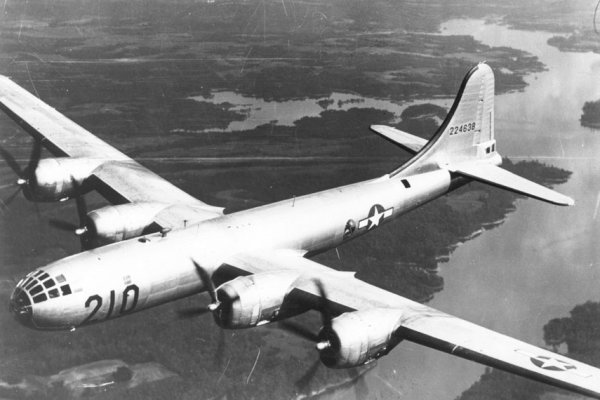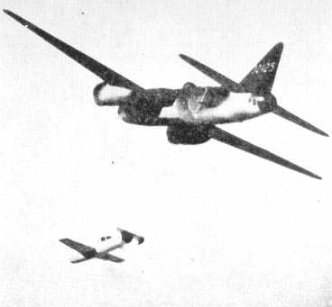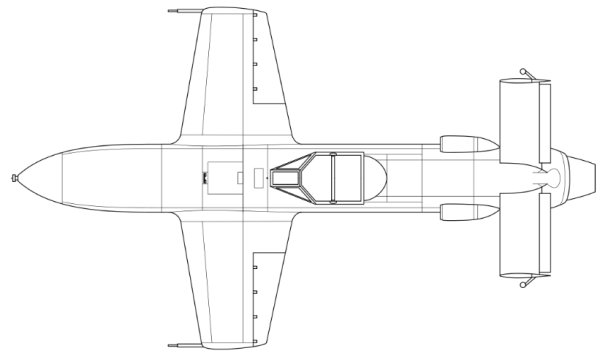ACUFO-1945-05-14-NORTHNAGOYA-1
On May 14, 1945, a raid of U.S. Army Air Forces B-29 bombers was performed on industrial sites of northern Nagoya, Japan. In the report for enemy opposition during mission 174, an incendiary daytime bombing attack, there was a report of “unusual enemy aircraft”:
4. Unusual Enemy Aircraft:
a. Over the target area, 1 crew reported 3 enemy aircraft maintaining such high speed that they were thought to be jet-propelled. They were described as single-engine aircraft with an extremely small wingspan and silver in color. They passed line astern under 1 of the formations going in the opposite direction at approximately 11,000 feet. The crew was unable to give further description due to the extreme speed of the aircraft in question. There is no indication that these aircraft later attacked.
| Date: | May 14, 1945 |
|---|---|
| Time: | Daytime. |
| Duration: | Brief. |
| First known report date: | 1945 |
| Reporting delay: | Hours. |
| Country: | Japan |
|---|---|
| State/Department: | Aichi |
| City or place: | Northern Nagoya. |
| Number of alleged witnesses: | 2 to 10. |
|---|---|
| Number of known witnesses: | ? |
| Number of named witnesses: | 0 |
| Reporting channel: | Military mission report. |
|---|---|
| Visibility conditions: | Day. |
| UFO observed: | Yes. |
| UFO arrival observed: | Yes. |
| UFO departure observed: | Yes. |
| UFO action: | |
| Witnesses action: | |
| Photographs: | No. |
| Sketch(s) by witness(es): | No. |
| Sketch(es) approved by witness(es): | No. |
| Witness(es) feelings: | ? |
| Witnesses interpretation: | ? |
| Sensors: |
[X] Visual: 2 to 10.
[ ] Airborne radar: [ ] Directional ground radar: [ ] Height finder ground radar: [ ] Photo: [ ] Film/video: [ ] EM Effects: [ ] Failures: [ ] Damages: |
|---|---|
| Hynek: | DD |
| Armed / unarmed: | Armed, 12 Browning M2 12,7 mm machine guns. |
| Reliability 1-3: | 3 |
| Strangeness 1-3: | 2 |
| ACUFO: | Possible trainer versions of the "Baka". |
[Ref. aaf1:] U.S. ARMY AIR FORCES:
In the report for Enemy opposition during mission 174, an incendiary daytime bombing attack on industrial sites of northern Nagoya, Japan, on 14 May 1945, there was a report of “unusual enemy aircraft”:

|
4. Unusual Enemy Aircraft:
a. Over the target area, 1 crew reported 3 enemy aircraft maintaining such high speed that they were thought to be jet-propelled. They were described as single-engine aircraft with an extremely small wingspan and silver in color. They passed line astern under 1 of the formations going in the opposite direction at approximately 11,000 feet. The crew was unable to give further description due to the extreme speed of the aircraft in question. There is no indication that these aircraft later attacked.
[Ref. aaf2:] U.S. ARMY AIR FORCES:
In the Air Intelligence Report, secret bulletin of the XXIst Bomber Command, we read, in a report about the same mission:

|
OPPOSITION
Approximately 48 enemy aircraft were encountered, resulting in 180 - 200 unaggressive and generally ineffectie attacks during the run from the assembly area until after bomb away. Three silver unidentified single engine aircraft, with extremely small wing span, approached B-29s of the 73rd Wing but did

|
not fire. Rate of closure was extremely fast and they were first thought to be jet-propelled, but no jets were observed.
The Boeing B-29 “Superfortress” was the heaviest bomber of the U.S. Army Air Forces, used in operations from May 8, 1944 and on. Its maximum speed was 574 km/h.
Its defensive armament was 12 Browning M2 12.7 mm machine guns.

|

|
At first sight, this report would seem very prosaic. A B-29 crew reported they saw fast planes with short wings, unpainted, and did not see them too well because of their speed. So what?
But it may not be that simple.
Firstly, it is historically impossible that they were jet planes. The U.S. Army Air Forces had no jet planes in operations in the Pacific during World War II. The Japanese air forces attempted to build jet planes, from the German Me-262 design, but they failed. The started to build two different copies of the German Messerschmitt Me-262, the Nakajima Ki-201 “Karyu”, whose single prototype was never completed, and the Nakajima “Kikka”, which only made one test flight of the single prototype on August 7, 1945, the day after the nuclear bombing of Hiroshima, and this prototype crashed.
Then, we have the “Baka”. “Baka” was the usual name the U.S. Air Forces gave to the Yokosuka MXY-7 “Ohka” rocket-propelled piloted suicide flying bomb. It did have shot wings. It was fast.
The “Baka” was dropped by a “Betty” bomber (photo below). Note that when the wings are visible, the tail is also visible.

|
Below, “Baka” wing and tail relative sizes.

|
We have no indication of the presence of the three “Betty” carrier planes, but one may think they were not visible for some reason, for instance, by being in the sunlight.
But, as always, the reports indicate they did not attack.
This would mean that the Japanese air forces would have sent 3 aircraft for nothing, and 3 pilots to death for nothing; unless of course one should think they did not attack the B-29's because were on their way to attack U.S Navy ships.
Historical sources document the Kamikaze missions. And yes, on May 14, 1945, the USS Enterprise aircraft carrier was hit by a Kamikaze attack. But it was not a “Baka”, it was a bomb-laden Japanese A6M5 Reisen “Zeke”, i.e. a conventional fighter plane. We know this happened “140 nautical miles from Miyazaki”, precisely 30°23'N, 132°36'E; this is much too distant from Nagoya.
Because there is sometimes a lack of indication about the given date being local or UTC, I also checked May 13, 1945, with this result:
USS Bache (DD-470), United States, Destroyer, Damaged, 13 May 1945 26°01'N, 126°53'E
But this was an attack by several conventional enemy dive bombers, one of them performing a suicide attack.
USS Bright (DE-747), United States, Destroyer escort, Damaged, 13 May 1945, 26°21'N, 127°17'E
And this was an attack by a conventional “Zeke” fighter that crashed on Bright's fantail.
On May 15, 1945, there were no Kamikaze attacks.
Thus, there was no Kamikaze attack launch near Nagoya at the time the 3 “unusual enemy aircraft” were sighted.
Also:
The “Baka” was not silver-colored. Except for prototype versions that were not used, (Type 11 was the only version used) it was painted white, or sky blue below and very light green on top parts; i.e., I found no photo or other evidence that silver-colored “Baka” have been flying.
The fact that the 3 “unusual enemy aircraft” flew in opposite direction relative to the B-29 is odd. “Baka” had only minutes of autonomy, they would have attacked the first B-29 they would have met.
U.S. Navy ships would not be anywhere near Nagoya when the sighting occurred. Most of the fleet was involved around Okinawa then, 1300 km away from Nagoya. (The distance the “Baka” could fly was no more than 40 km).
All this being said, there is nevertheless a possibility that the three unidentified aircraft were indeed “Baka”.
Whereas a “Baka” attack on the B-29 would mean the loss of the “Baka” pilot, all “Baka” aircraft were not always piloted to a certain death. One version was not: the trainer version, developed and operational in 1945.
In addition to the normal version, Yokosuka also built 45 “MXY7-K1” trainers. They were reusable because they were equipped with flaps and a landing skid, as shown on the photo below, showing the Baka trainer on display at the National Museum of the United States Air Force, Wright-Patterson AFB, Dayton, Ohio.

|
Hence, a possible explanation for this sighting report is that the crew saw a group of three Baka trainers. They would not have attacked the B-29 because the bomb was simulated by a heavy weight of water in the nose. This water ballast was expelled before landing, still a difficult operation because landing speed was around 130 mph. Of course, Baka trainer flights were only performed by day with good visibility of the ground.
Of course, the one at the National Museum of the United States Air Force is painted orange, not silver. But I was unable to find data that would prove none of the 44 others were silver.
Possible trainer versions of the “Baka”.
* = Source is available to me.
? = Source I am told about but could not get so far. Help needed.
| Main author: | Patrick Gross |
|---|---|
| Contributors: | None |
| Reviewers: | None |
| Editor: | Patrick Gross |
| Version: | Create/changed by: | Date: | Description: |
|---|---|---|---|
| 0.1 | Patrick Gross | July 8, 2024 | Creation, [aaf1], [aaf2]. |
| 1.0 | Patrick Gross | July 8, 2024 | First published. |